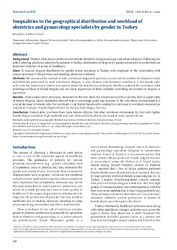Inequalities in the geographical distribution and workload of obstetrics and gynaecology specialists by gender in Turkey
| dc.contributor.author | Erus, B. | |
| dc.contributor.author | Tuncay Alpanda, Berna | |
| dc.date.accessioned | 2023-06-22T10:59:43Z | |
| dc.date.available | 2023-06-22T10:59:43Z | |
| dc.date.issued | 2022-06 | |
| dc.identifier.issn | 1020-3397 | en_US |
| dc.identifier.uri | http://hdl.handle.net/10679/8460 | |
| dc.identifier.uri | https://applications.emro.who.int/EMHJ/V28/06/1020-3397-2022-2806-418-424-eng.pdf | |
| dc.description.abstract | Background: Women often have a preference for female obstetrics and gynaecology specialists (ob/gyns). Following the policy allowing physician selection by patients in Turkey, distribution of ob/gyns by gender across provinces has been an important indicator of access to healthcare. Aims: To analyse ob/gyns distribution by gender across provinces in Turkey, with emphasis on the relationship with conservativeness of the province and resulting physician workload. Methods: We measured the number of male and female ob/gyns by province in 2016 and the number of outpatient visits and deliveries performed by male and female ob/gyns in 2015. Pearson and Spearman correlation of the female ratio with votes for conservative parties was used to assess the distribution of ob/gyns. We then analysed the correlation with resulting workload of female ob/gyns and ran linear regressions of these variables controlling the number of ob/gyns in a province. Results: More conservative provinces, measured by the vote share for conservative political parties, have a higher ratio of female ob/gyns. Linear regression showed that a 1 percentage point (pp) increase in the vote share corresponded to a 0.69 pp increase in female ratio. For workload, a 1 pp higher female ratio resulted in a decrease in workload, measured as outpatient visits per female ob/gyn divided by that per male ob/gyn, by 0.014. Conclusion: Conservative provinces have more female ob/gyns, but other provinces compensate for that with higher female ob/gyn workload. High workload may have adverse health effects and result in lower quality of care. | en_US |
| dc.language.iso | eng | en_US |
| dc.publisher | World Health Organization | en_US |
| dc.relation.ispartof | Eastern Mediterranean Health Journal | |
| dc.rights | Attribution-NonCommercial-ShareAlike 3.0 IGO (CC BY-NC-SA 3.0 IGO) | * |
| dc.rights | openAccess | |
| dc.rights.uri | https://creativecommons.org/licenses/by-nc-sa/3.0/igo/ | * |
| dc.title | Inequalities in the geographical distribution and workload of obstetrics and gynaecology specialists by gender in Turkey | en_US |
| dc.type | Article | en_US |
| dc.description.version | Publisher version | en_US |
| dc.peerreviewed | yes | en_US |
| dc.publicationstatus | Published | en_US |
| dc.contributor.department | Özyeğin University | |
| dc.contributor.authorID | (ORCID 0000-0001-6398-1123 & YÖK ID 258769) Tuncay, Berna | |
| dc.contributor.ozuauthor | Tuncay Alpanda, Berna | |
| dc.identifier.volume | 28 | en_US |
| dc.identifier.issue | 6 | en_US |
| dc.identifier.startpage | 418 | en_US |
| dc.identifier.endpage | 424 | en_US |
| dc.identifier.wos | WOS:000879940500004 | |
| dc.identifier.doi | 10.26719/emhj.22.037 | en_US |
| dc.subject.keywords | Geographic distribution | en_US |
| dc.subject.keywords | Obstetrics and gynaecology | en_US |
| dc.subject.keywords | Patient preference | en_US |
| dc.subject.keywords | Physician workload | en_US |
| dc.subject.keywords | Turkey | en_US |
| dc.identifier.scopus | SCOPUS:2-s2.0-85133980053 | |
| dc.relation.publicationcategory | Article - International Refereed Journal - Institutional Academic Staff |
Files in this item
This item appears in the following Collection(s)
Share this page




